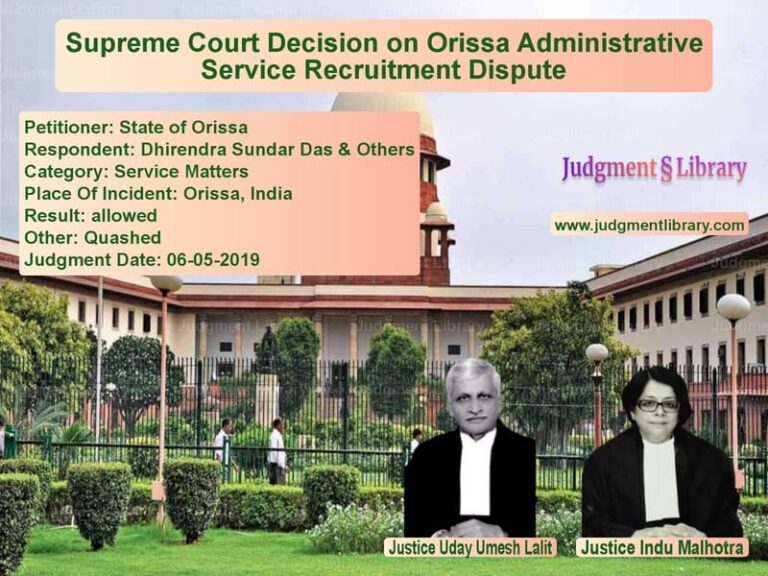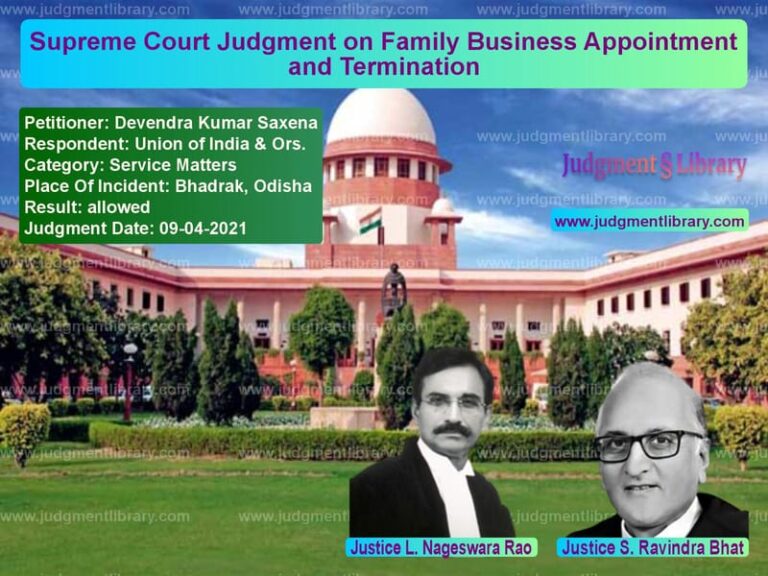Criminal Conspiracy and Abetment of Suicide: Saeeda Khatoon Arshi vs State of UP & Anr.
This case involves an appeal filed by the appellant, Saeeda Khatoon Arshi, against the decision of the Allahabad High Court, which allowed an application under Section 482 of the CrPC to quash the summoning order under Section 319 CrPC. The appellant’s daughter, Juhi Arshi, died under suspicious circumstances, and the appellant alleges that her son-in-law, the second respondent, was involved in her death. The issue at hand is whether the Trial Court correctly summoned the second respondent for trial under Section 319 of the CrPC based on the evidence presented during the trial.
Key Facts of the Case:
- Juhi Arshi, the daughter of the appellant, was married to the second respondent in 2007. On the night of 9th-10th June 2017, the appellant received a call from the second respondent informing her that her daughter had hanged herself. Upon reaching the house, the appellant found the body of her daughter, but suspected foul play.
- The appellant’s complaint included claims of harassment and abuse by the second respondent, his family members, and their friend Manoj Shrivastav, who allegedly instigated the suicide.
- The appellant filed a First Information Report (FIR) on 14th June 2017 after delays, claiming that her daughter had been murdered and not that she had committed suicide. The body was exhumed, and a post-mortem was conducted, but due to decomposition, the cause of death could not be determined conclusively.
- A charge sheet was filed, and after hearing the evidence, the appellant sought the summoning of the second respondent under Section 319 CrPC for his involvement in the crime. The Trial Court issued summons to the second respondent on 29th January 2019, based on the evidence presented. The High Court, however, set aside the order, leading to the current appeal.
Petitioner and Respondent Arguments:
Petitioner (Saeeda Khatoon Arshi): The petitioner contended that the Trial Court had correctly invoked Section 319 CrPC to summon the second respondent based on the strong circumstantial evidence. She argued that the second respondent was the sole person present with her daughter at the time of the incident, and his actions after the incident, including hastily burying the body and refusing to inform the police, raised suspicions of foul play. The petitioner highlighted that the Trial Court had thoroughly considered the evidence of PW-1 and PW-2 before issuing the summons.
Respondent (State of UP & Anr.): The respondents argued that the High Court had correctly intervened in the summoning order as the evidence was insufficient to implicate the second respondent. The respondents maintained that the Trial Court had overstepped its powers and that there was no direct evidence linking the second respondent to the crime. They also contended that the appellant had failed to provide any substantial evidence to charge the second respondent with abetment to suicide.
Important Judge Arguments:
Justice Dhananjaya Y Chandrachud: Justice Chandrachud noted that the power under Section 319 CrPC is an extraordinary power that should be exercised sparingly. He emphasized that the evidence adduced during the trial must be sufficient to show that a person other than the accused has committed an offence that could lead to their prosecution. In this case, the evidence provided by the appellant (PW-1 and PW-2) was critical in linking the second respondent to the crime, and the Trial Court had rightly exercised its discretion in summoning him. The Court also referred to the principles established in earlier cases where the Trial Court can exercise its powers under Section 319 based on the evidence led during the trial, even if no formal charge is brought against the person being summoned.
Justice Hrishikesh Roy: Justice Roy concurred with the judgment, emphasizing the importance of the Trial Court’s findings based on circumstantial evidence. The Judge noted that the second respondent’s role in the death of Juhi Arshi was highly suspicious, especially considering the urgency with which the body was disposed of, and the lack of an explanation from the second respondent. The Court reiterated that the Test under Section 319 CrPC is to determine whether there is enough evidence to show that a person could be found guilty if the evidence were unrebutted. Justice Roy further added that the High Court had failed to properly evaluate the facts and had wrongly set aside the order of the Trial Court.
Legal Provisions Discussed:
- Section 319 CrPC (Power to proceed against other persons appearing to be guilty of an offence): This section gives the Trial Court the power to summon an individual for trial if it appears from the evidence presented that they are guilty of an offence and could be tried together with the accused.
- Section 306 IPC (Abetment of Suicide): The charge against the second respondent was under Section 306 IPC, which deals with the offence of abetment to suicide.
- Section 106 of the Evidence Act: The Court discussed the applicability of this provision, stating that the second respondent, being the only person present with the deceased, had the burden of explaining the circumstances surrounding the death.
- Section 113 of the Evidence Act (Presumption as to certain facts): The Court considered whether there was a presumption of guilt against the second respondent due to the suspicious circumstances surrounding the death and the lack of a reasonable explanation from the second respondent.
Final Judgment:
The Supreme Court allowed the appeal, setting aside the High Court’s order and reinstating the summons issued by the Trial Court under Section 319 CrPC. The Court found that the Trial Court had correctly evaluated the evidence and that there was sufficient prima facie evidence to summon the second respondent. The case was remitted to the Trial Court for further proceedings, and the second respondent was directed to face trial along with the other accused.
Conclusion:
This judgment highlights the importance of the discretion given to Trial Courts under Section 319 CrPC to summon additional accused persons based on the evidence presented during the trial. The case also reinforces the need for proper investigation and a fair trial, ensuring that all persons involved in a criminal offence are held accountable.
Petitioner Name: Saeeda Khatoon Arshi.Respondent Name: State of UP & Anr..Judgment By: Justice Dhananjaya Y Chandrachud, Justice Hrishikesh Roy.Place Of Incident: Moradabad, Uttar Pradesh.Judgment Date: 10-12-2019.
Don’t miss out on the full details! Download the complete judgment in PDF format below and gain valuable insights instantly!
Download Judgment: Saeeda Khatoon Arshi vs State of UP & Anr. Supreme Court of India Judgment Dated 10-12-2019.pdf
Direct Downlaod Judgment: Direct downlaod this Judgment
See all petitions in Murder Cases
See all petitions in Theft and Robbery Cases
See all petitions in Suicide Cases
See all petitions in Judgment by Dhananjaya Y Chandrachud
See all petitions in Judgment by Hrishikesh Roy
See all petitions in allowed
See all petitions in supreme court of India judgments December 2019
See all petitions in 2019 judgments
See all posts in Criminal Cases Category
See all allowed petitions in Criminal Cases Category
See all Dismissed petitions in Criminal Cases Category
See all partially allowed petitions in Criminal Cases Category







